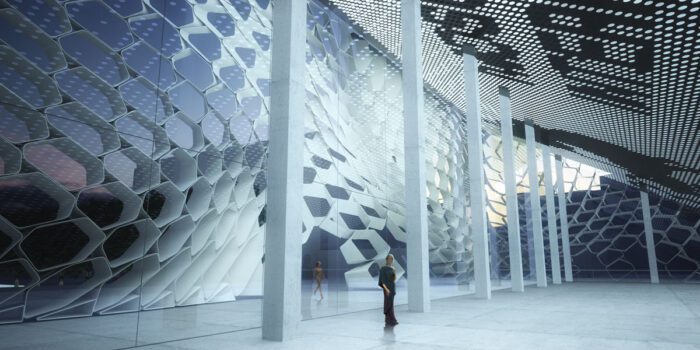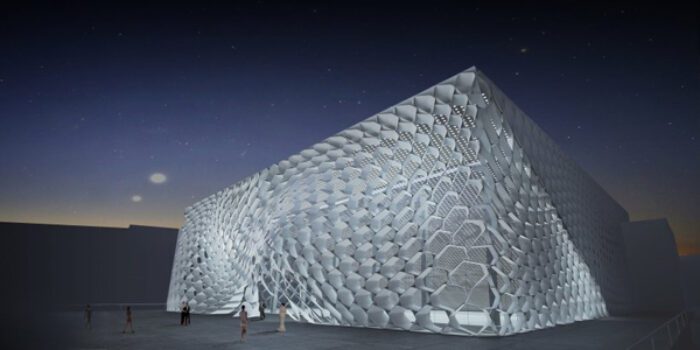This, the competition submission by Synthesis Design + Architecture, for a new facade of the Pushkinsky Cinema, is something we’ve all seen, yet not quite like this. Located on Pushkin Square in Moscow, Russia, the cinema, with it’s unique, some might say brutalist, architectural expression, is named in honour of the great poet, who is known (to me at least) for interesting rhythmic usages. Well this submission’s certainly got rhythm, and not all the same rhythm either. The facade is similar in concept to a growing number of pavilions and other small scale pieces, but I believe this is the first time I have seen it on a large scale such as this. If I’m wrong, so-be-it, leave a comment. Either way, it’s good to see. These are the sort of new ideas that need to start to be actually implemented. We’ve theorized for long enough, let actually do some of this stuff.  Well, the creators go a bit more in-depth than my pep-talk has, so they’re gonna close this one out. Take it away. The design of the Pushkinsky Cinema facade renovation places the face of the landmark venue behind a sculptural veil which acts as a dramatic backdrop to Pushkin Square and an iconic face to the cinema. Inspired by the screened views, geometric intricacy and flowing surfaces of a “Russian Veil”, the design contrasts the imposing presence of the Brutalist architectural icon by simultaneously enclosing and revealing its contents behind a delicate yet robust open air lattice materialized as thermo-formed sheets of DuPont Corian. The solid mass of the building is clad in a series of Corian panels which gently morph the relentless diagrid pattern of the existing facade into a flowing and varied matrix of warped hexagon modules.
Well, the creators go a bit more in-depth than my pep-talk has, so they’re gonna close this one out. Take it away. The design of the Pushkinsky Cinema facade renovation places the face of the landmark venue behind a sculptural veil which acts as a dramatic backdrop to Pushkin Square and an iconic face to the cinema. Inspired by the screened views, geometric intricacy and flowing surfaces of a “Russian Veil”, the design contrasts the imposing presence of the Brutalist architectural icon by simultaneously enclosing and revealing its contents behind a delicate yet robust open air lattice materialized as thermo-formed sheets of DuPont Corian. The solid mass of the building is clad in a series of Corian panels which gently morph the relentless diagrid pattern of the existing facade into a flowing and varied matrix of warped hexagon modules.  The composite effect of the varied orientations of the hexagonal screen components creates a rich and dramatic moiré effect which dissolves from opaque to transparent and back again as one moves around, through and within the building. With each step the building appears to change through the interplay of light, shadow, and visual connectivity as the thin 13mm thick Corian sheets nearly disappear upon perpendicular viewing while those at oblique angles to the viewer are revealed through their 500mm depth. This dynamic effect encourages visual interaction and connectivity between the cinema and Pushkin Square by simultaneously revealing and concealing the contents of the cinema through a multiplicity of varying and directed views into and out of the lobby.
The composite effect of the varied orientations of the hexagonal screen components creates a rich and dramatic moiré effect which dissolves from opaque to transparent and back again as one moves around, through and within the building. With each step the building appears to change through the interplay of light, shadow, and visual connectivity as the thin 13mm thick Corian sheets nearly disappear upon perpendicular viewing while those at oblique angles to the viewer are revealed through their 500mm depth. This dynamic effect encourages visual interaction and connectivity between the cinema and Pushkin Square by simultaneously revealing and concealing the contents of the cinema through a multiplicity of varying and directed views into and out of the lobby.

